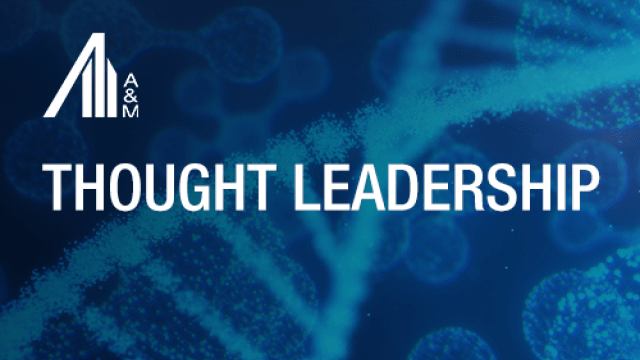Artificial Intelligence (AI) and Machine Learning (ML) for Healthcare – Are You Ready?
This is the first edition in our series that will explore the most recent challenges and transformation across the healthcare industry, and where healthcare is headed with implementation of AI and ML technologies.
Introduction – AI and ML: What’s the Difference?
With the proliferation of generative AI, such as ChatGPT, Bard and GPT-4, there is a lot of confusion between AI and ML and how they can and may be utilized in healthcare, as well as their potential challenges and inherent risk.
In healthcare, machine learning and AI are often used interchangeably but they refer to different aspects of the same technology.
AI in healthcare typically involves the use of advanced algorithms and machine learning techniques to perform tasks that would normally require human intelligence. For example, AI-powered diagnostic tools can analyze medical images or patient data to help doctors make more accurate diagnoses [or identify prior misdiagnosis]. AI can also be used to automate certain administrative tasks, such as Revenue Cycle Management (RCM), slot management, appointment scheduling or medical record management.
Alternatively, ML in healthcare specifically refers to the use of algorithms that can learn from data to improve performance on a given task. This can involve training models on large datasets of patient records or medical images to identify patterns and relationships that would be difficult for humans to discern. ML can be used for a wide range of healthcare applications, such as predicting patient outcomes, identifying patients at risk of developing certain conditions, or optimizing treatment plans.
The real differentiator of AI in healthcare is a broader term that encompasses a range of technologies and techniques, while machine learning is a specific subset of AI that involves training algorithms to learn from data. Both are important for improving healthcare outcomes, but they are applied in slightly different ways, depending on the specific use case.
- ChatGPT
Given the interchangeable use by the industry today, several of the underlying key considerations to implement and achieve successful deployment and outcomes of AI and ML initiatives are highlighted below.
What Is AI/ML in Healthcare?
With the rapid rise of AI and ML, many healthcare organizations are urgently trying to understand the potential use cases, benefits and risks of implementing this technology. There are various AI and ML frameworks available for purchase or open source, as well as flexible web application and programming languages to build upon; therefore, selecting the appropriate mechanism can be challenging. Applications of AI/ML in healthcare range from the use of intelligent computer systems to enhance clinical decision-making, performing complex medical data analysis and improving operational efficiency via workflow and resource management. Regardless of the application, the data model and AI/ML platforms need to initially be designed with extensibility and the ability to be maintained.
The road to deliver or capitalize upon robust AI and ML is far more than a series of technical deliverables. It’s a holistic view into the potentially competing business priorities, compliance and regulatory hurdles, as well as fragmented delivery of care touchpoints impacting the patient, provider or staff experience. Organizational users need to become familiar with the technological options, practical applications and the challenges utilizing single-sourced data sets for one department. While technical acumen, data governance and many other IT-focused assets will undoubtedly be important, developing a culture that utilizes, adopts and embraces AI and/or ML for its unlimited value will determine success or failure.
AI/ML Use Cases in Healthcare
AI and ML can unlock a healthcare organization’s ability to derive deeper insights into current data sets, automate manual processes and assist humans in completing complicated tasks. Depending on strategic organizational goals and challenges across people, processes and technology, there are several areas in which AI/ML can be prioritized:
- Revenue Cycle Management (RCM)
- Contact Center
- Workflows identified for staffing optimization
- Remote Patient Monitoring (RPM)
- Symptom triage and routing of care
- Clinical Decision Support (CDS)
- Referral identification and workflows
- Risk Adjustment (RA)
- Patient outreach and communication workflows (inbound and outbound)
- Test results and wound identification
- Billable/debt collection methods
- Authorization of services/Utilization management
- Claims adjudication
- Provider data management
- Population health/Predictive analytics
AI/ML models can increase efficiency in RCM by leveraging real-time claims; i.e., learning which cases require prior authorization requests, automating payer submissions and checking statuses. ML models are “taught" how to think and assess data sets, diminishing barriers to entry for organizations seeking proprietary out-of-the-box insights and applications. These ML insights can then automate AI workflows or digital outreach to improve RCM outcomes and simplify the patient experience.
Reinforcement learning algorithms can optimize the performance of AI and ML applications by allowing the system to learn from interactions and adjust responses accordingly; the algorithm can be trained and adjusted to its input-based decision-making strategy.
AI/ML – Where Can It Go Wrong?
At times, leaders over-index on the technical aspects of data and AI/ML activation. While data maturity and quality are foundational elements to successful ML and AI applications, there are other key aspects to take into consideration:
- Data precision. Codify sources of value as data products: analytic profiles and insight-generating models.
- Partnership selection. Determine AI/ML product or partner with the required resources to implement AI/ML initiatives at scale.
- Source of value. Identify sources and measures of value creation across your business (customer, operational, product, etc.) as the North Star objective for AI/ML utilization.
- Integration. Operationalize data products by embedding them in core business systems and processes.
- Governance. Govern data products to ensure ongoing responsible use, value creation across stakeholder and future scalability.
The Criticality of Data Sources
Utilizing data sets from a single source of truth is one aspect of the cumbersome extraction, transformation and loading process required to ensure clean and quality data. Correspondingly utilizing data sets from multiple sources of truth poses additional challenges to validate the source of truth. Thus, a team of experts is needed to build, manage and audit the output of a selected tool, and an organization must be purposeful in the implementation to realize the expected benefits. Implementation necessitates a robust infrastructure. Key requirements include:
- Data storage and management
- High-performance computing
- Network infrastructure
- Integration with existing systems and human expertise
- Legal review and risk evaluation of data sources and how data sets are built
Building and leveraging a next generation AI/ML technology will not be possible without a programmatic approach and a governance-focused, multi-faceted team composed of data scientists, AI/ML specialists, software developers, healthcare professionals, design ethicists and data analysts. This team should drive the strategy, design, implementation and management of an AI/ML solution.
Data Maturity and Integrity
While there are several key components to enable the success of AI/ML, one of the most important considerations for a reliable AI/ML system is the accuracy and completeness of the data sources. AI/ML models require efficient data, representative of the population, that is properly cleaned, prepared and validated to maintain data quality. Any errors or gaps in these data sources could lead to inaccurate or biased predictions, corresponding insights and recommendations.
Another important consideration is to select appropriate statistical methods and techniques to analyze the data and build the appropriate models to enable AI or ML. Depending on the nature and complexity of the data, different methods may be more suitable and effective. For example, some methods may be better at handling missing values, outliers, nonlinear relationships, interactions, multicollinearity or heteroscedasticity. Some methods may be more interpretable, transparent and explainable than others, which could enhance the trust and acceptance of the system by its users.
Another consideration is to validate and evaluate the models using appropriate metrics and criteria. The models should be tested on unseen data to assess their generalization ability and robustness. The models should also be compared against benchmarks or baselines to measure their relative performance and improvement. The metrics and criteria used to evaluate the models should reflect the objectives and expectations of the system, such as maximizing collections, minimizing costs, enhancing customer satisfaction or complying with regulations.
Potential Bias, Risk, Security and Privacy Concerns – Setting Expectations for AI and ML Technology
As AI and ML technologies constantly evolve, human interaction will continuously be needed, to adapt to changing processes, flag errors, add new data sets and evaluate areas for potential bias.
“Set it and forget it” is not a phrase that will enable benefit realization from AI and ML technologies. Further, data bias is a critical issue in AI development, particularly when training models. For instance, a skin cancer detection model trained solely on data from lighter skin-toned individuals may not accurately identify skin cancer in people with darker skin tones, potentially leading to misdiagnosis and delayed treatment. To mitigate bias, diversified design teams should be employed to collect and use heterogenous information sets, check for and correct biases in the data before training the model, and regularly test and evaluate for new biases.
Risk can be managed by designing AI/ML solutions with ethical considerations involving a multidisciplinary team, ensuring privacy and accountability, protecting patient privacy and confidentiality, and routinely assessing the performance of your AI/ML systems.
There are numerous legal considerations, as end user privacy policies and procedures need to be carefully evaluated while also ensuring you have the proper rights to the underlying data utilized. When looking to utilize, build or design AI/ML applications, what types of representations and warrants would you need to ensure that your company is protected from the inherent risk of accessing and relying on third-party data or patient data without the proper consent at the proper time or level of care?
As you consider security, a multi-layered security approach should be implemented, and solutions should be HIPAA, PCI, GDPR, FTC and CFR 42-Part 2 compliant to ensure the security of sensitive data. Existing security policies and procedures need to be evaluated while gathering requirements related to data sharing, security, quality, reporting, analytics and governance, to provide proper authentication, authorization, access and auditing of data and information assets. Techniques such as secure data storage and transmission, systematic vulnerability scans and compliance validation can be applied to safeguard sensitive data.
Deployment Considerations
To successfully deploy and integrate AI and ML use cases within healthcare, the below should be considered and assessed for viability:
- Data infrastructure and technology stack. AI/ML requires a robust and scalable IT infrastructure to handle the processing, storage and analysis of large volumes of patient data. The data infrastructure and technology environment may need to be upgraded to ensure compatibility and performance.
- Workflow adjustments and standardization. To maximize the benefits, existing operational workflows and processes may need to be redesigned or streamlined. This could involve reassigning tasks, redistributing workloads or updating processes to better align with the AI-driven system.
- Security and compliance. Proper administrative, technical and physical safeguards need to be in place. Policies and procedures must be assessed for gaps against compliance standards to ensure data privacy and security.
- Workforce training. Staff must be trained in the new technology and its applications to ensure effective use. This includes understanding the AI/ML-driven processes, interpreting the insights generated and knowing how and when to involve human intervention.
- Change management. Deploying and integrating new systems require significant change management efforts to ensure successful adoption across an organization. A comprehensive change management plan is necessary to address employee training, communications and ongoing support.
- Enterprise data management. New data management practices may need to be adopted, ensuring that data feeding the solution is accurate, up-to-date and properly maintained. This may involve implementing data validation, cleansing and standardization processes.
- KPIs and performance metrics. “You don’t achieve what you don’t measure.” An organization should define and track key milestones and metrics to measure effectiveness and continuously identify areas for improvement.
Conclusion – Find the Right Partner to Accelerate Innovation in Action
It is imperative that healthcare organizations recognize the transformative potential of ML and AI and take action to integrate these technologies into operations, reporting and clinical processes.
AI and ML are not one-size-fits-all solutions. Implementation success depends on finding the right fit for your organization’s unique appetite, capabilities and goals. Successful application and implementation can be achieved by identifying and collaborating with strong technical and operational partners — prioritizing compliance and bias mitigation, starting with manageable projects and rapidly iterating upon learnings. It may seem like a daunting task to undertake, but by starting with manageable projects, healthcare organizations can gather valuable insights to adopt ML and AI technology into their culture, leading to more efficient processes, improved profitability and a better experience for staff, providers and patients.






